This flour washed seitan tastes and slices like roast beef! This seitan beef is made from two ingredients- beet juice and bread flour! (With some seasonings and broth….)
Seitan is very high in protein and low in starch- making it an ideal for anyone who wants to eat more protein. When this seitan is sliced thin, it is incredibly similar to roast beef. That makes it ideal for sandwiches, gyros, wraps, and more! It is also fantastic for broken up into chunks and pan fried in sauce.
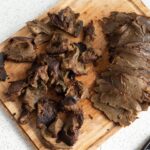
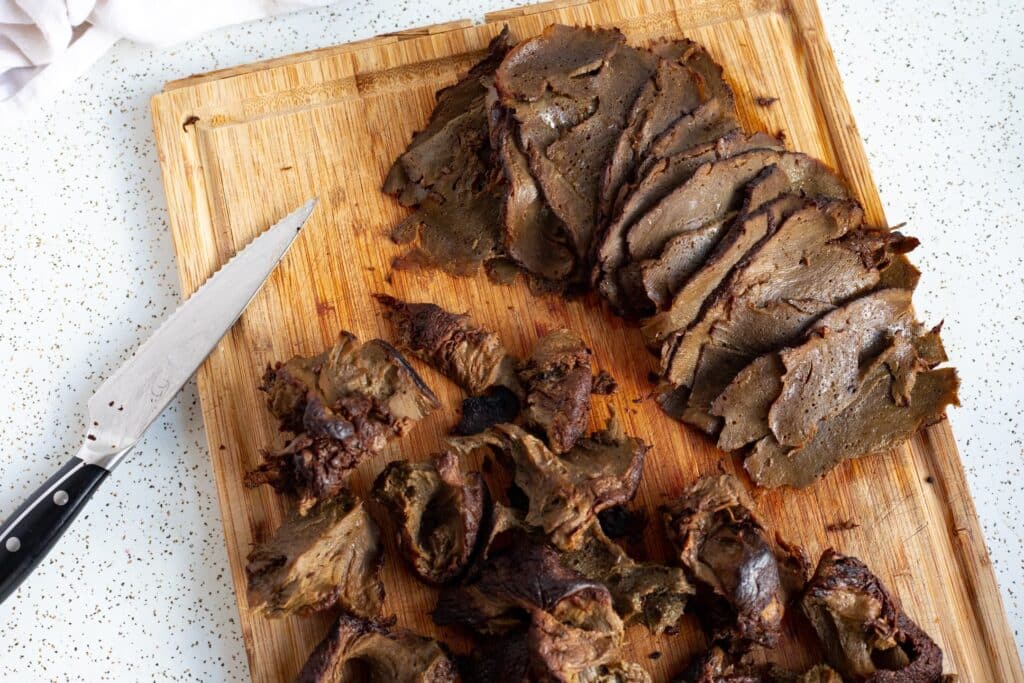
Seitan, made from bread flour is very high in protein.
According to Cronometer 4 ounces of seitan has 120 calories, 24 grams of protein, 4 grams carbs, and 1 gram fat.
Bread flour is about 13% protein, this recipe has you remove all the starch from the flour. That leaves you with pure wheat protein, or gluten.
While this might seem like a new vegan thing, this recipe originates in China from about 2,000 years ago. Buddhist monks invented this recipe, and would often make noodles from the washed away starch to fry with the gluten.
Roast Beef Seitan Schedule
Be mindful of that this recipe is a slow and beautiful process. It is mostly hands off time- very similar to sourdough baking.
This recipe has the best results if you take 3 days to make it.
You can make it in two days for a good result- but you’ll have the most satisfying texture if you let the seitan rest for an additional day.
Day 1: Mix together the flour and beet juice into a dough. Cover (submerge) in salt water overnight.
Day 2: Wash the ball of dough, season, and shape the seitan. Pan fry it, then simmer it overnight in broth.
Day 3: Remove from the broth and let chill in the refrigerator.

Vegan Beef Seasoning
At this point stretch out your seitan and sprinkle over your seasonings. Rub it into the dough. The dough is very elastic and difficult to work with. It’s ok if not all of the seasonings get incorporated into the dough.
Focus on seasonings that are savory, high in iron, and pair with beef flavors.
Later, we simmer the seitan. When it simmers it will expand and absorb the broth it is cooking in. The broth will be the majority of flavoring your seitan. Many recipes don’t have you season your seitan at all because the broth will flavor it.
So if your seasonings don’t penetrate the dough- it’s no big deal! I’ve found gently rubbing it in can be helpful but there is still some seasonings that don’t get penetrated.
Instead of using the seasoning blend in the recipe, you can use a vegetarian beef bouillon to flavor it. I don’t do this because maltodextrin upsets my stomach and it’s in premade broths so I avoid it.
At this point let the dough rest for about an hour to help it firm up.
Step 1: Making Vegan Beef
In a large bowl add your bread flour to beet juice to form a dough. This is about 6 cups of beet juice to a 5 lbs bag of flour. The exact amount of beet juice doesn’t matter too much as long as you are able to make a solid ball of dough that you can knead. Since I used a bottle of beet juice I ended up needing to add an additional cup of water to make the dough come together.
To make beet juice at home you’ll need about 10-12 large beets for this recipe.
Let it rest for an hour to autolyze (allow the gluten to start to form).
You can either knead the dough, or you can stretch and fold the dough (think bread making) to help develop the gluten. Knead it or stretch and fold the dough until it is smooth and elastic. (See the video to see an example of ready dough)
At this point you will cover the dough with water and sprinkle in about 1-2 tablespoons of salt.
The salt is helpful in this stage because
1. Salt enhances the hydration of gluten proteins, which makes them more elastic and cohesive
2. Salt reduces the free sulfhydryl groups (SH) in gluten proteins, which are responsible for breaking and reforming disulfide bonds (S-S) that link different protein chains together. This means that salt stabilizes the gluten network and prevents it from breaking down easily.
3. Salt increases the beta-sheet structure of gluten proteins, which is a type of secondary structure that gives them strength and rigidity
4. Salt promotes the macromolecular aggregation of gluten proteins, which means that they form larger complexes with each other.
In another words, salt helps make the gluten stronger. This helps you have a higher yield since less gluten will be broken down when washing.
Often when people are washing the flour, the ball of dough falls apart. This can be a result of not kneading your dough enough, not letting it rest enough, or not using salt when letting it rest.
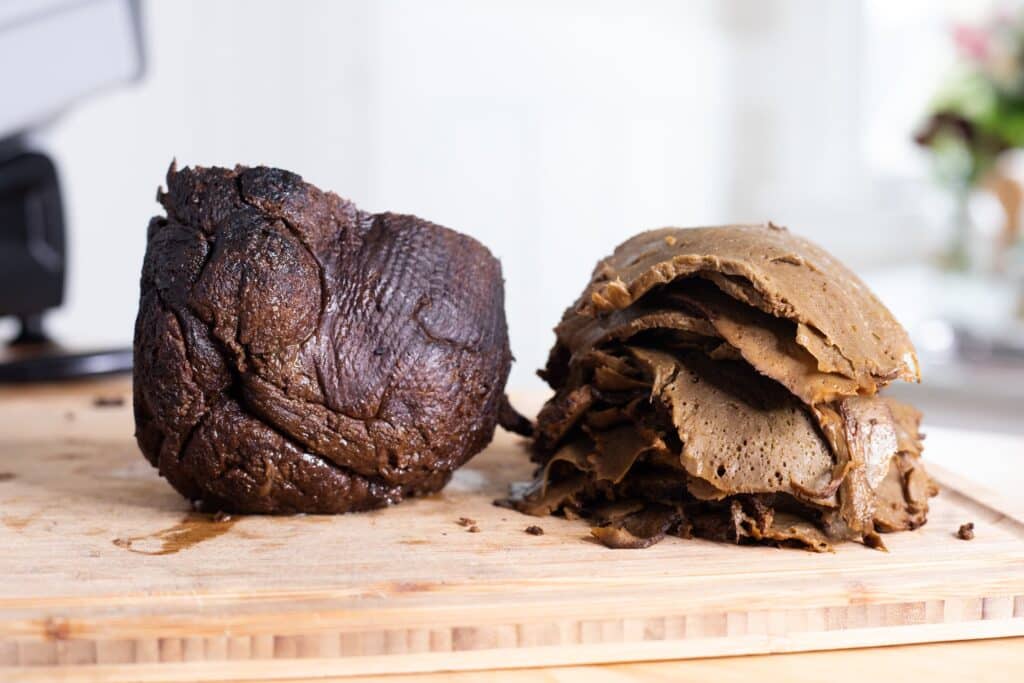
Step 2: Wash the Flour
The next day pour off the water from the ball of dough. Grab a second large bowl and a strainer to help collect the wheat starch. It’s helpful to have a few large jars to save your wheat starch too.
Pour cold water over the ball of dough and begin to knead it, be gentle to not tear the gluten. Cold water helps the gluten seize up and helps keep the ball of dough stay together.
Continue kneading until the water becomes very thick and milky. Pour away the starchy water into your glass jars to save for another recipe. Use a strainer to help prevent gluten from entering the starch water.
Repeat the process of kneading the ball of dough and straining the starchy water about 6 times.
At the 4th or 5th wash the seitan can be pretty loose. Remember to use cold water and to be gentle- it will come back together as the starch washes out.
Don’t save the starch after the 5th wash because it tends to be very watered down and isn’t worth the extra time.
Continue to wash it until there is little to no starch left, the dough ball will go from light pink to a darker mauve.
Step 3: Shaping Your Seitan
Shaping your seitan is the most important if you are planning on breaking it up into beef chunks. If you are planning on slicing your seitan this is unnecessary.
Roll your seitan out into a long rope and tie it into many knots, and then knot it to itself. The knots help add shreddy texture to the seitan.
Step 4: Frying the Seitan
As gluten cooks in broth it expands, absorbing the broth. If it expands too much your seitan will have little bubbles- creating a spongy texture. The tight knots you did in the last steps will help with the texture, but more measures need to be taken.
Frying the exterior of the seitan helps create a seal- a skin if you will, that helps it from expanding too much.
Bring a frying pan to a high heat and add 1/4 cup of coconut oil. Add the knotted seitan and fry the exterior. Be careful flipping it since it’s a decent sized loaf. I use two spatulas to flip it carefully. Fry it until it has a golden-brown exterior.
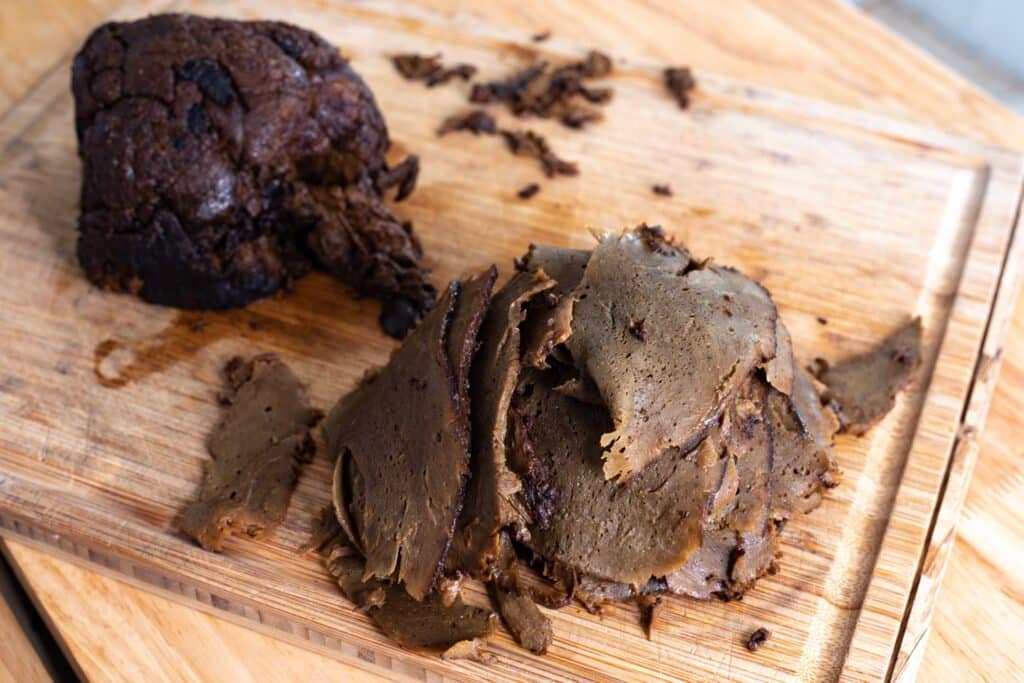
Step 5: Simmering
Place your fried seitan into a stock sock or inside of a cheesecloth. Wrap it tightly! This is another measure to help keep the seitan having a shreddy texture.
You can create your own broth for simmering the seitan or you can use a premade vegan beef broth. If you are using a premade broth (like from a carton) add in extra seasonings.
This is where the seitan is getting most of its flavor! Create a concentrated, hyper flavorful broth!
Consider creating a broth with black garlic, caramelized onions, fennel, thyme, mushrooms seasoning, MSG, smoked salt, smoked paprika, and smoked yeast.
The seitan has the best result if you let it simmer overnight.
Use a slow cooker on an Instant Pot on the slow cooker setting is the easiest way to do this. You can simmer your seitan on the stove, but it is risky.
The reason it is best to cook your seitan on low on slow cook in the instant pot or on low in a slow cooker is that is has a controlled low temperature.
If the temperature is too high when you cook seitan it will expand quickly- and create large holes. The holes create a spongy texture.
The seitan needs to be cooked at a low temperature to prevent that expansion. If you cook it on the stove, it is easy to accidentally have it at too high of a temperature.
The seitan needs to be simmered slowly, so slowly that it is barely bubbling. Since it is cooked at such a low temperature, it needs at least 8 hours to be cooked through the middle.
You can’t overcook the seitan when it is simmering like this. You will have a marvelous result if you leave it to simmer for 24 hours.
Ways to Serve the Seitan
Try the seitan sliced thin into a sandwich, gyro, or wrap! Or break it into chunks for a plant based twist on brocoli and beef. Comment below what you made with it!
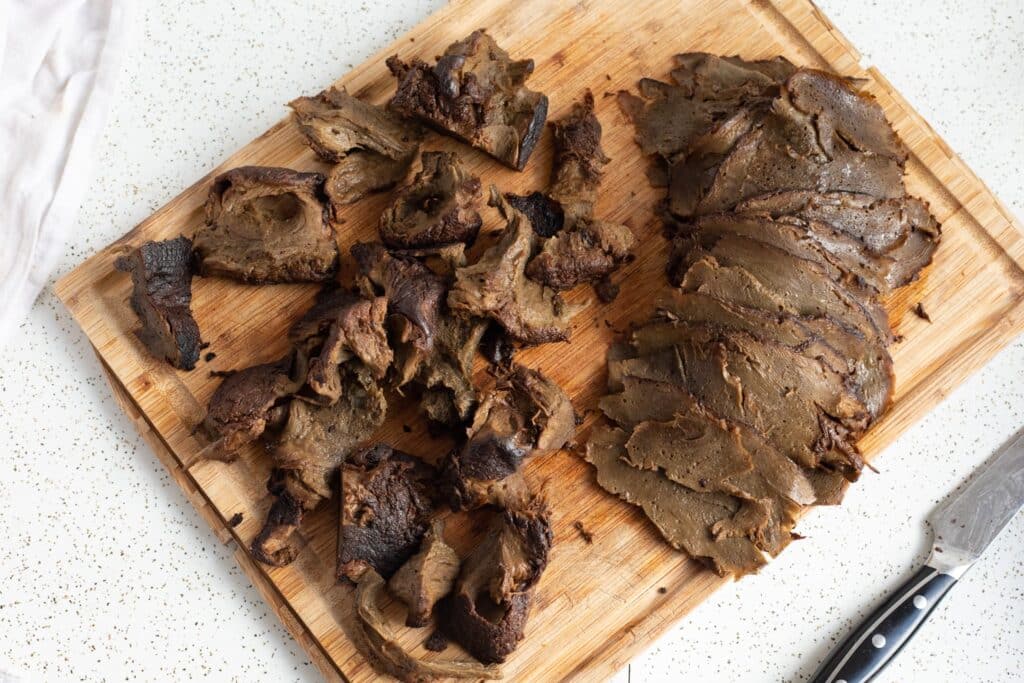
Looking for other Vegan Staple Recipes?
- If you are looking for a seitan that is more like chicken try out this flour washed seitan chicken recipe!
- If you love seitan beef, how about seitan steak? This seitan steak recipe is perfect for grilling season!
- Cultured Sunflower Cream Cheese is a probiotic cream cheese that is perfect for smears!
- Try saving some money by making your mayo at home! This sunflower mayo has hidden health benefits from the addition of Irish sea moss.
- Looking for another vegan chicken recipe? Try this Kentucky fried hen of the woods! It’s a meaty, juicy mushroom that tastes chicken-like!

Beef Seitan
Equipment
Ingredients
- 6 cups Beet Juice
- 5 lbs Bread Flour
- 2 tbs Sea Salt
- 10 Vegan Beef Broth or use a premade vegetable or mushroom broth
Seasonings
- 2 tbs Mushroom Seasoning
- 2 tbs Nutritional Yeast Flakes
- 1 tbs Blackstrap Molases
- 1 tsp Black Garlic Powder or Roasted Garlic Powder
Instructions
- In a large bowl, combine the bread flour with the beet juice. Let it rest for 1 hour, then stretch and fold it on all sides. The dough should be smooth.
- Pour over enough water to cover the dough in your bowl, then sprinkle over the sea salt Let this rest overnightA longer rest helps the dough develop gluten without you having to knead the dough. If you don't knead the dough long enough or let it rest long enough, you will have a smaller yield. In another words, the protein needs to be worked or have time to develop in order to prevent waste. You will have an easier time washing the dough after a long overnight rest and some initial kneading.
- Pour out the water the dough was sitting in and refill the bowl with cold water. Knead the dough under the cold water and you'll notice clouds of white starch separating from the dough. Continue to do knead until the water is thick with the starch.Using a strainer, strain away the starch water from the dough.Pour the starch into jars and save for another recipe.Continue to knead the dough and pour out the starch water until the dough washes away clear.You'll notice the seitan will start off light pink and as you wash it, the dough turns mauve. You'll notice ribbons of light pink- that is starch that needs to washed more.
- Stretch out your dough and sprinkle over all the seasonings. Knead it into the dough by stretching and folding it.Some of the seasonings won't be worked into the dough- that's ok, just work as much as you can into itLet it rest for 1 hourHave some towels on hand, the seitan will leak water as it rests
- Stretch out your dough and fold it into itself. Then squeeze it out into a long rope. Create tight knots throughout the dough. Knot the dough into itself to create a knotted loaf.This helps create a shreddy texture.
- Add a pan to high heat and add Coconut Oil. Pan fry the knotted loaf of dough until most of exterior is golden brown (roughly 5-7 minutes)
- Using either a cheesecloth or stock sock, place your loaf inside and tightly wrap it.
- Add 8-10 cups of premade Vegetarian Beef Broth or Vegetable Broth to a slow cooker or Instant Pot.Or you can start a batch of vegan beef broth now
- Add the wrapped loaf to the broth and slow cook on low for 10-24 hours. (You can't overcook seitan this way, it's best on a very low heat for a long time*)Do Not Simmer at Too High of a Heat! This will cause the seitan to expand too quickly and result in bubbles that will lead to a spongy texture.
- Remove from the broth. If you let it rest overnight at this point the gluten will continue to develop into a very shreddy and firm seitan. However, this is completely optional! It is ready to eat/ cook with at this point!Slice it thin, or break it up into chunks!
It turned out fabulous!!! I will say I used canned beets because I already had some I didn’t know what to do with and blended them to make the juice. It didn’t work at all and all of the color and flavor 100% washed out so it just looked like normal washed gluten. So if you want the color or flavor use fresh beets and beet powder. That being said, somehow the flour washed better and easier than any of my seitan ever has, so maybe canned beets are magic?? Anyway, the flavor was fantastic as was the texture. Absolutely would recommend.
Hello! Can the bread flour be substituted for vital wheat gluten in a 1:1 ratio?
I wouldn’t because vital wheat gluten has a distinct flavor that you would need to mask. You would also want to add in some kind bean or starch because pure vital wheat gluten can be very rubbery in texture